Bill simplifies tiered utility rates
Now that the $42 billion bill for the 2001 California Energy Crisis has been paid off, California’s current four price tiers for electricity will be flattened to two tiers over the next four years.
Environmentalists who advocated for cleaning up air quality by shutting down old, obsolescent power plants are going to find that renewable power did not, in the long-run, bring about conservation-inducing tiered power rates. Moreover, this consolidation of pricing tiers will bring about the demise of rooftop solar power, which was economic only because the top two tiers for electricity were higher priced than the solar power.
Current pricing model
On April 21, the California Public Utilities Commission announced it was rolling out a new plan that would overhaul electric utility rates.
 As shown in the adjacent chart, today, electric utilities charge for power based on four increasing rates. The lowest rates is 15 cents per kilowatt-hour; and the highest more than double at 31 cents. The CPUC would reduce the price tiers to two and flatten the price difference between the tiers from 106 percent today to 20 percent by 2019.
As shown in the adjacent chart, today, electric utilities charge for power based on four increasing rates. The lowest rates is 15 cents per kilowatt-hour; and the highest more than double at 31 cents. The CPUC would reduce the price tiers to two and flatten the price difference between the tiers from 106 percent today to 20 percent by 2019.
The result would be that those with higher rates today will have their monthly electricity bill reduced and those at the bottom two price tiers will see their electricity bills increase.
AB327 phases out Top tiers of power rates by 2020
This is the result of California Assembly Bill 327 sponsored by Assemblyman Henry Perea, D-Fresno, which was signed into law by Gov. Brown on Oct. 7, 2013. However, AB327 still provides for discounts for low-income electricity customers whose electricity bills do not exceed 30 to 35 percent of their income under the California Alternate Rates for Electricity program.
AB327 specifically states that the original reason for the four to five price tiers was to pay off the $42 billion bill accumulated due to the California Energy Crisis of 2001. That bill was loaded into Department of Water Resources power purchases to pump water through the State Water Project (see page 4 here). Conservation was never the primary purpose of the higher price tiers, which were expanded after 2001 so that wealthier customers would mainly pay off the huge debt incurred in 2001 to mothball older, dirtier power plants.
Progressive Pricing Coming to End
Evan Gillespie of the Sierra Club says of the new rate structure: “It jacks up bills for low-income customers, lets energy hogs off the hook and will slow the transition to clean energy.”
Bottom line for customers in PG&E, Edison, and SDG&E service areas:
- Use very little electricity? Pay more than you did last year.
- Use a lot more electricity? Pay less than you did last year.
- Use an average amount? Pay about the same as last year.
But the era of Progressive pricing of electricity, where coastal ratepayers used 50 percent more power but paid 100 percent higher rates, will be coming to an end in 2020.
Current Electricity Price Structure for Regulated Public Utilities:
| Tier | Price | Details (Four-Tier Price Structure) | |
| 1 | 15¢ | Your monthly billing cycle begins in Tier 1, where the price per kWh is lowest. About a quarter of our customers never exceed Tier 1 for the length of their billing cycle. | |
| 2 | 19¢ | Customers move in to Tier 2 when they’ve exceeded their Tier 1 allotment. Tier 2 costs 4 cents more. | |
| 3 | 25¢ | The price per kWh increases by 6 cents in Tier 3. If you’re in this tier, you’re using a considerable amount of energy. | |
| 4 | 31¢ | Not all customers go up to this tier during their billing cycle, but if you max out the previous 3 tiers, the price per kWh in Tier 4 is over twice the price of Tier 1. | |
| Fixed Charges | |||
| 93¢ | Monthly Basic Charge – This is a flat daily charge that is billed on a monthly basis | ||
| Residential Rate Plan – Schedule D* (price/kWh) | |||
Related Articles
CA GOP’s acceptance of Log Cabin Club a major culture war win — reflects 4-decade battle
California’s gay Republicans, after four decades at the margins, finally have won recognition from their party. At this month’s state GOP
New report details California lawmakers accepting gifts
A new report by California Common Cause shows that elected officials in California accepted hundreds of thousands of dollars worth
Electric cars upend CA politics
As California’s electric car industry heats up, Sacramento’s role in incentivizing the vehicles for environmentalist reasons has become an uncharacteristic




